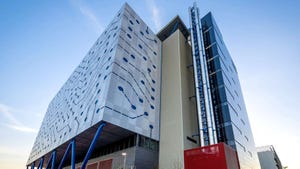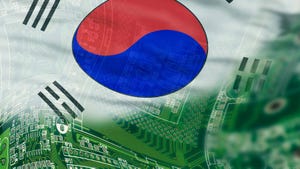
Insight and analysis on the data center space from industry thought leaders.
The Green Revolution: How Data Centers Are Making AI SustainableThe Green Revolution: How Data Centers Are Making AI Sustainable
The use of digital twins can enhance data center sustainability by optimizing resources and integrating renewable energy, writes Mark Seymour.
June 18, 2024

Did you know that a single ChatGPT query uses over 10 times as much energy as a Google search? If you did, it should come as no surprise that influential figures, including National Grid CEO John Pettigrew, are advocating for reforms to lessen the strain on the UK’s electrical infrastructure to support AI’s growth.
Meanwhile, environmental regulations are forcing data centers to minimize their energy consumption, leaving them searching for a solution to power AI innovation more sustainably. At present, facilities are investigating the potential of renewable energy to resolve both the challenge of lowering grid load and minimizing carbon emissions. However, introducing other energy sources like solar and wind is complex and requires careful planning and implementation. Luckily, there’s a solution that can help.
Before making major modifications, facilities can use digital twins to support their designs and operations. These virtual replicas of the physical data center can simulate designs based on new energy solutions to ensure their compatibility and efficiency before implementing them in the actual facility. Before we dive into the promise of digital twins further, it’s critical to understand why we need them in an increasingly AI-dominated society.
An Imminent Capacity Crisis
Data centers are already under immense capacity strain. The rapid progress of AI is adding to this issue, with figures from CBRE revealing that European data center demand (511MW) outstripped supply (467MW) across the five largest European markets in 2023. What’s more, power use effectiveness (PUE) scores, which indicate how well a data center uses energy, are stagnant. While some best-in-class data centers score 1.1, many scores are now locked at 1.5. In some cases, this equates to an astounding five times waste of energy.
AI will only worsen these challenges with the enormous amounts of storage and processing power needed by algorithms. That requirement is anticipated to skyrocket over the coming years, with much of the anticipated GW increase attributed to AI. As AI continues its exponential ascent, these numbers will only increase.
Maintaining the energy supply needed to power data centers effectively isn’t simple. People around the world have seen firsthand how capacity demands can affect the grid. For example, blackouts occurred in California in 2017 and 2019, and there have been recent warnings in some parts of the US about the possibility of power disruptions due to AI causing a surge in energy demand. This is drawing more attention to how difficult it is to maintain a stable power grid and energy supply. However, the difficulties do not stop there.
The Sustainability Story
Energy-hungry data centers house complex equipment that needs a constant supply of energy for servers, storage, networking, etc. However, that’s not the only resource facilities consume on a large scale. The average data center uses 3-5 million gallons of water a day – that's equivalent to the water use of a city with up to 50,000 people. Public interest in facilities is growing because of this, particularly when combined with the growing demand for energy. Now, as local governments, people, and councils voice their growing objections, plans for new data centers are being publicly denied.
Legislators and regulators are also closely monitoring data centers. Changes to regulations mean that companies that depend on data centers will no longer be able to shift their emissions down the supply chain. For instance, the Energy Efficiency Directive (EED) and Corporate Sustainability Reporting Directive (CSRD) will mandate that large corporations report on their carbon usage, both directly and indirectly.
To add to the complications, facilities are aware that using conventional energy sources may restrict their sustainability, but they still need to power AI. As a result, executives are looking for solutions that will allow them to simultaneously satisfy AI expectations and environmental, social, and governance (ESG) targets. Renewable energy is a strong option.
Countries like Singapore, the Netherlands, and Ireland are already actively looking into alternative energy sources to power their data centers. By using solar, wind, and other renewable energy sources, data centers will reduce both their carbon impact and the likelihood of blackouts.
A renewable drive is also likely to decrease public and local government resistance to upcoming data center construction, making project approvals easier. However, above all, ensuring that all traditional and renewable power is used as effectively as possible in existing data centers should be the primary objective for facility managers.
Using Digital Twins to Achieve Sustainability
Many modern data center managers seek to fulfill sustainability standards, adhere to regulatory requirements, and meet AI's growing power demands. That's where the many benefits of digital twins come into play.
To begin with, higher power densities associated with AI technologies especially must be cooled effectively and efficiently. Digital twins can be utilized to assess the effectiveness of heat rejection into the environment as well as the efficiency of cooling supply in the white space. This is necessary to prevent growing power density from undermining free cooling techniques and the ensuing explosion in energy consumption.
A further benefit is that digital twins are essential for realizing the complete potential of renewable energy sources in broader data center operations. Data center managers can identify the best configurations for their specific requirements by using digital twins. These models can dynamically adjust to the variations in energy sources by considering cooling tactics and resource allocation. By using this strategy, facilities can minimize their environmental impact and optimize their use of renewable energy.
Finally, digital twins enable continuous monitoring of resource utilization across the facility. Combining sensors and data collection mechanisms with digital twins, operators have the power to assess the performance of various components, such as cooling efficiency, power consumption, and network bandwidth, in real time.
Such insights can be analyzed to identify energy concerns and, in turn, address resource allocation or stranded capacity issues. These advantages make operations more environmentally friendly and can result in promising PUE scores or other metrics developed to be more suitable for liquid cooling and hybrid systems. With this in place, operators can confidently investigate the incorporation of renewable energy sources.
Driving AI Uptake Safely
A sole reliance on conventional energy in the wake of AI’s growth will not work if it’s to be powered more sustainably. Digital twins, however, can guide leaders through this journey by enabling them to optimize resource utilization across the entire facility and save significantly on energy.
This reduces the strain of energy demand, all while providing a clear view of their environmental impact. The data centers that turn to digital twins will be better equipped to handle AI's challenges and open the door to a more sustainable digital future.
Mark Seymour is distinguished engineer at Cadence.
About the Author
You May Also Like









